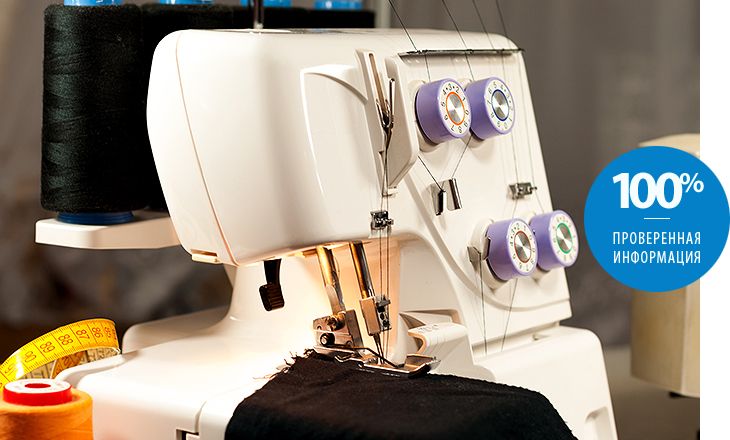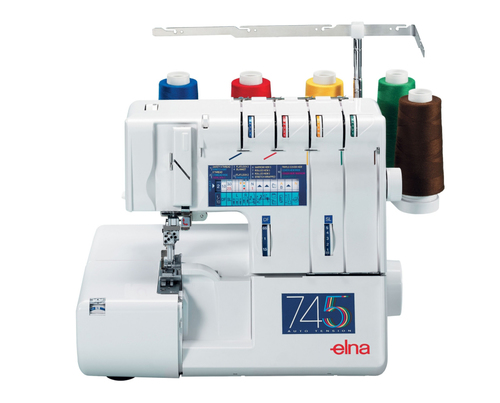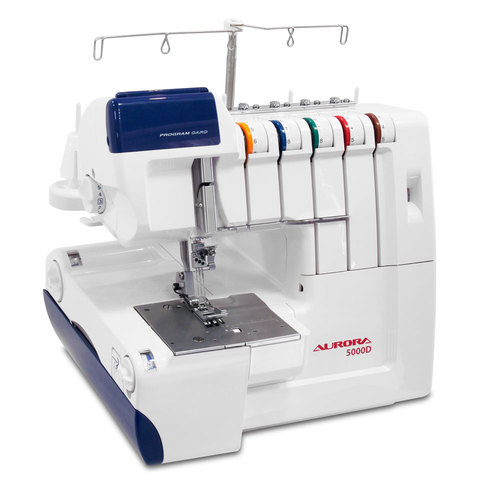
Sewing clothes at home for themselves and their loved ones is a favorite hobby of many women. Someone even brings a regular income. At first, the craftswomen are costing sewing machines with overlock stitching. But if you want to make the appearance of your sewing masterpieces more professional and presentable, or even turn a hobby into a business, you can't do without an overlock.
The overlock's main task is to tack the edges of the fabric around the seams in order to protect them from blooming.
The seams treated with overlock do not crumble, stretch (this is important on knitwear) and look neat. The first cars were produced only for the sake of this operation. Modern overlocks are more functional: they are able to do embroidery, decorate decorative seams, sew several layers and trim excess fabric smoothly. What are the parameters for choosing an overlock for your home?
The main criteria for choosing an overlock
Looper options, seam options
The looper determines the nature of the weave of threads and determines the number of lines that can be performed at a time. We recommend choosing the type of looper depending on the seams that will most often be performed. Overlock can be 2, 3, 4, 5-filar.
What are the options for seams and what are their advantages?
- Three thread seams - The simplest of all, while strong and reliable. They can be performed on two loopers that are available in each, even a budget overlock.
- Double thread seams are possible only on condition that the looper is equipped with a converter (an additional part is put on the upper looper before work). This seam is less voluminous than the three-filament, useful when working with thin fabrics.
- Four thread seam requires two lower loopers. This seam is designed specifically for stitching parts simultaneously with their overlay. If the overlock is capable of 4-thread suture, it means that it has a 3-thread, otherwise it does not happen.
- Five stitches seam requires three loopers. This seam is the widest, therefore it is excellent for overcasting heavily flowing fabrics.
Three-thread seam - standard. The most common models of overlockers just 3,4-filar. For more complex seams need more coils. From this threading becomes more difficult, although the assortment of lines expands. Examples of overlockers that can make a 5-thread seam are Juki MO-75E, AstraLux 8000CL, Bernina 1300MDC
Convenience threading
There is nothing prohibitively difficult in overlocks, although threading for beginners is as “understandable” as a dark forest. But it is quite possible to master it in the process. At first, of course, the work will progress more slowly than we would like, but when you put your hand, you will not even need a scheme. With experience you will be able to thread, as they say, with closed eyes.
Nevertheless, manufacturers are trying to help users. Most models have threading guides (in different colors for easier process). By the way, in order to familiarize yourself with this mechanism, it is recommended that at the beginning of your acquaintance with a machine, you need to fill it with threads of different colors - in the color of the scheme (red, blue, yellow, green, look at your own scheme) - and train with them in refueling and tuning. Very clearly.
Some also have an extra hand-threader (like, say, a sewing machine). If you don’t want to spend precious moments of creative inspiration on routine threading, choose an overlock with a vacuum thinker.
The most dreary part of the procedure is the filling of the lower looper. The new Janome models (the same MyLock 714D), as well as the Juki 654 and 735, Elna 664PRO, and others have an auxiliary mechanism especially for this.
Demanding Threads
When your overlock recognizes only branded threads, there may be problems with it. What if they run out in the nearest store? And there are such threads, respectively. If you sew a lot, think about whether you splurge on consumables. Unpretentious to the threads, for example, Janome MyLock 714D, Brother M-1334D or Elna 664PRO.
Transporter
High-quality overlock stitching makes the product more durable and beautiful. But in the presence of defects, it can spoil the whole product, despite the fact that it is on the wrong side. In order not to be upset because of unevenly made seams, choose a model that has a transporter for the fabric - it will not allow it to stretch or shrink into a tube while overcasting the edge.
Differential fabric feed (independent adjustment of the front and rear conveyor) is a very convenient function, it is better not to save money when choosing an overlock on it. In most popular models, it is, but when buying is worth clarifying.

Presser foot pressure regulator
It is also a useful feature if you work with fabrics of different density. There is, for example, Janome MyLock 784D or Brother 3034D. For thicker fabrics, the pressing force is made smaller, and the machine passes thickening easier. And when working with knitwear, the pressure regulator is invaluable, otherwise the material will be strongly stretched under the foot. Models with automatic adjustment themselves take into account the type of fabric.
Availability of available service
Especially when you take overlock for home business! Before buying, make sure that the service of this brand is in your city. Otherwise you suffer with maintenance and repair.
Additional overlock features
Choosing overlock, besides the main criteria, you should pay attention to the presence of the following functions:
- The ability to perform a role seam. If you like to sew curtains made of tulle, knitted or chiffon dresses for your daughter, then you need an overlock, which at the same time with the overlay makes a thin role seam, twisting the edge of the detail, otherwise you will not be able to cope with these moody fabrics.
- Flatlock (flatlock, a seam that looks like a flat) - useful if there is no sewing machine, and a flat seam is still needed
- Stitch width It is of great importance. Why spend money on the overlock, which is able to sweep products only at a distance of 5 mm from the edge? Such overlapping width is not suitable for heavily flaking fabrics (silk, satin, lining fabrics).
- Thread Tension Regulator on one axis - the most convenient in operation.
- Sleeve platform make it easier to cover the sleeves and the bottom of the trousers. Although many craftswomen consider the removable hose platform absolutely useless. Those items of clothing for which they are really needed (for example, children's clothing sleeves) should not be pulled onto the platform due to the small diameter. And parts with a large diameter can be processed without a platform. In addition, the removable platform complicates cleaning.
- The built-in tray for scraps of fabric and threads (garbage container) - an additional trifle, although very convenient. Dirt while working becomes much less! Janome MyLock 714D (644D), Вrother 1034D and others have a dustbin, but the Brother 355D does not have one.
Best Overlock Manufacturers
Which overlock manufacturers have won fame from the masters of their craft?
Dear professional-grade overlocks (50 000-70 000 r. And above) - this is Japanese Babylock and swiss Bernina. It was Bernina, by the way, released at the end of the XIX century. the world's first sewing machine for processing edge seam-hemming. Overlocks of this class are multifunctional, easy to refuel and adjust, perform 15-20 (or even more) sewing operations, are equipped with a display, have good lighting. But their main advantage is the ability to work with any fabrics, even with chiffon in 1 layer, even with jeans in several additions.
To the middle class (in the price range of 20 000-40 000 p.) Can be attributed overlock Pfaff, AstraLux, Brother, Elna, Janome, Juki, Singer. Most of the models of these firms are simple, unpretentious and reliable. Suitable for work at home or in small workshops.
Low-cost overlocks (up to 15,000 rubles on average) are Merrylock aurora, and more (despite the names) Jaguar and TOYOTA. These machines break more often, the quality of the lines is lower, but they are more accessible. The possibilities of the budget overlock will be enough for home sewing from time to time.
If we place overlock of different manufacturers for quality and reliability, then we put Bernina and Juki in the first place. Also noteworthy are the models Elna, Janome and Brother.

Photo: www.sew-online.ru
Common customer mistakes
If you are not an overlock specialist, you can easily choose a model that is completely unsuitable for your needs. To prevent this from happening, we invite you to familiarize yourself with the four most common errors. So, what better not to do when choosing an overlock:
- Strive to save for the sake of saving. Buyers think: I don’t have enough money for a good model, so for now I’ll take it easier. Do not do it this way. A cheap NoName overlocker (non-branded) may not cope with your fabrics, it will upset the complexity of the settings - and in general it will quickly break. If there is not enough money, it is better to buy a branded model, but not in a store, but in the secondary market. On Avito type bulletin boards or forums for needlewomen you can find quite a good secondhand copy, because normal overlocks live a long time.
- Mindlessly carried on the assurances of sellersthat only this model is worth attention, and all the rest - complete ... nonsense. Unfortunately, as a rule, in stores, customers are advised of the goods that they need to sell now. It is no secret that sales assistants are more often sellers than consultants. And they have the opportunity to present any machine in an unfavorable light, or vice versa, to embellish, if necessary. Therefore, such “consultations” should be divided into two and ask for the advice of independent artists.
- Compare models based on digital characteristics only., which are given in the descriptions of online stores. If overlock performs more operations, it does not mean that it is better. See your needs. Perhaps you have enough simple trehnitki.
- Buying a carpetlock without much need. If you need all the functions, there is enough space and money, it is better to take a separate overlock and embroidery machine. Otherwise, you will have to change the settings twice as often. Constant reconfiguration from a role seam to a rasposhivalny and back takes time. And when you sew a lot, buying two cars will be more profitable.
Which overlock is better to choose?
Contrary to popular belief, you should not compare overlock models with each other only by the characteristics on the Internet. The reliability of the model, the build quality is really important, and how well the machine sews! Therefore, we highly recommend choosing overlock only live, that is, go to the store and try everything with your own hands, sew different materials - and better on different machines nearby. Even reviews should not be relied upon 100%, because for one master the quality of the seam on this model of overlock will be suitable, and for the other - unsatisfactory. Need to draw your own conclusions. And do not trust the sellers too much, because sometimes they are dominated by the desire to sell (over the desire to help).
On the other hand, retail prices are often overpriced. Therefore, buying overlock is cheaper through the online store. So, as a rule, they do it - they choose it in the store, they order it on the Internet.
We wish you a happy shopping and creative inspiration!
